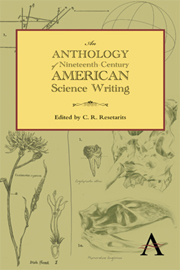Book contents
- Frontmatter
- Contents
- Preface
- Part One 1800–1846 Naturals and Naturalists
- Part Two 1846–1876 Warriors
- Part Two Introduction
- “On the Fossil Horses of America,” Proceedings of the Academy of Natural Sciences of Philadelphia (1847)
- “A Flora and Fauna Within Living Animals” (excerpt), Smithsonian Contributions to Knowledge (1853)
- “Examination of the Radiations of Red-Hot Bodies. The Production of Light by Heat” (excerpt), American Journal of Science and Arts (1847)
- “Section IX: Range of the Geographical Distribution of Animals,” Essay on Classification (1857)
- “On the Origin of Species” (excerpt), American Journal of Science (1860)
- “Darwin on the Origin of Species,” Atlantic Monthly (1860)
- “Sequoia and Its History” (excerpt), American Naturalist (1872)
- “On the Origin of the Geographical Distribution of Crustacea” (excerpt), Annals and Magazine of Natural History (1856)
- “On Cephalization” (excerpt), New Englander (1863)
- “On some Results of the Earth's Contraction from cooling, including a discussion of the Origin of Mountains, and the nature of the Earth's Interior” (excerpt), American Journal of Science (1873)
- “On Comets and Meteors,” Proceedings of the American Philosophical Society (1869)
- “Linear Associative Algebra,” A Memoir read before the National Academy of Sciences in Washington, 1870 (excerpt), American Journal of Mathematics (1881)
- “The Laws of Organic Development” (excerpt), American Naturalist (1871)
- “Fossil Horses in America,” American Naturalist (1874)
- “Odontornithes, or Birds with Teeth,” American Naturalist (1875)
- “The Genesis of Species” (excerpt), North American Review (1871)
- Part Three 1876–1900 Scientists
- Bibliography
“Fossil Horses in America,” American Naturalist (1874)
from Part Two - 1846–1876 Warriors
Published online by Cambridge University Press: 05 June 2012
- Frontmatter
- Contents
- Preface
- Part One 1800–1846 Naturals and Naturalists
- Part Two 1846–1876 Warriors
- Part Two Introduction
- “On the Fossil Horses of America,” Proceedings of the Academy of Natural Sciences of Philadelphia (1847)
- “A Flora and Fauna Within Living Animals” (excerpt), Smithsonian Contributions to Knowledge (1853)
- “Examination of the Radiations of Red-Hot Bodies. The Production of Light by Heat” (excerpt), American Journal of Science and Arts (1847)
- “Section IX: Range of the Geographical Distribution of Animals,” Essay on Classification (1857)
- “On the Origin of Species” (excerpt), American Journal of Science (1860)
- “Darwin on the Origin of Species,” Atlantic Monthly (1860)
- “Sequoia and Its History” (excerpt), American Naturalist (1872)
- “On the Origin of the Geographical Distribution of Crustacea” (excerpt), Annals and Magazine of Natural History (1856)
- “On Cephalization” (excerpt), New Englander (1863)
- “On some Results of the Earth's Contraction from cooling, including a discussion of the Origin of Mountains, and the nature of the Earth's Interior” (excerpt), American Journal of Science (1873)
- “On Comets and Meteors,” Proceedings of the American Philosophical Society (1869)
- “Linear Associative Algebra,” A Memoir read before the National Academy of Sciences in Washington, 1870 (excerpt), American Journal of Mathematics (1881)
- “The Laws of Organic Development” (excerpt), American Naturalist (1871)
- “Fossil Horses in America,” American Naturalist (1874)
- “Odontornithes, or Birds with Teeth,” American Naturalist (1875)
- “The Genesis of Species” (excerpt), North American Review (1871)
- Part Three 1876–1900 Scientists
- Bibliography
Summary
It is a well-known fact that the Spanish discoverers of America found no horses on this continent, and that the modern horse (Equus caballus Linn.) was subsequently introduced from the old world. It is, however, not so generally known that these animals had formerly been abundant here, and that long before, in Tertiary time, near relatives of the horse, and probably his ancestors, existed in the far west in countless numbers, and in a marvellous variety of forms. The remains of equine mammals, now know from the Tertiary and Quaternary deposits of this country, already represent more than double the number of genera and species hitherto found in the strata of the eastern hemisphere, and hence afford most important aid in tracing out the genealogy of the horses still existing.
The animals of this group which lived in this country during the three divisions of the Tertiary period were especially numerous in the Rocky Mountain regions, and their remains are well preserved in the old lake basins which then covered so much of that country. The most ancient of these lakes – which extended over a considerable part of the present territories of Wyoming and Utah – remained so long in Eocene times that the mud and sand, slowly deposited in it, accumulated to more than a mile in vertical thickness. In these deposits, vast numbers of tropical animals were entombed, and here the oldest equine remains occur, four species of which have been described.
- Type
- Chapter
- Information
- An Anthology of Nineteenth-Century American Science Writing , pp. 177 - 183Publisher: Anthem PressPrint publication year: 2012



